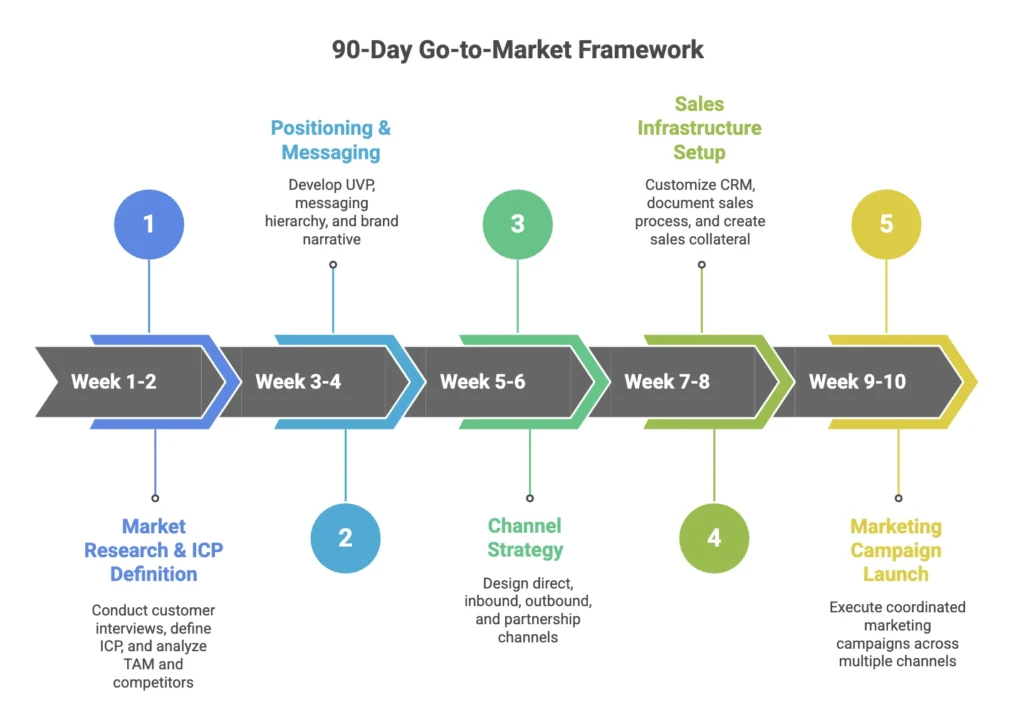Most startups burn through their runway building products in isolation, only to discover that “build it and they will come” is startup suicide. The reality? “Build it and they will come!” is quite possibly the number one attitude that kills great ideas and early stage startups. Here’s your complete 90-day framework for turning product ideas into predictable revenue through strategic GTM services that actually work.
Why 90 Days Is the GTM Sweet Spot
The 90-day timeline isn’t arbitrary, it’s based on how B2B sales cycles actually work. Sales teams track key performance indicators (KPIs), like those tied to reaching revenue and sales targets within 30, 60, or 90 days post-GTM launch.
Most enterprise software has a 3-6 month sales cycle, meaning your 90-day sprint needs to feed that pipeline consistently. The data shows that adding a GTM operations team at a typical B2B company can reduce overhead by 30%, improve sales productivity by 10%, and increase marketing ROI by 100%, but only when properly structured.
The 90-Day GTM Framework
Days 1-30: Foundation and Market Fit Validation
Week 1-2: Market Research and ICP Definition
The biggest mistake startups make is skipping market validation. A go-to-market (GTM) strategy is a detailed plan of how your startup will reach its target customers effectively and efficiently, where effectiveness depends on how rapidly you reach and convert customers and efficiency on how profitable your efforts are.
Market Research Deliverables:
- Detailed Ideal Customer Profile (ICP) with firmographics and psychographics
- Total Addressable Market (TAM) analysis with bottom-up calculations
- Competitive landscape mapping with feature and pricing comparisons
- Customer journey mapping from awareness to purchase decision
Validation Framework:
- 50+ customer discovery interviews with target prospects
- Problem-solution fit validation using Jobs-to-be-Done methodology
- Pricing sensitivity analysis through conjoint studies
- Channel preference research through customer interviews
Week 3-4: Positioning and Messaging Development
Transform research insights into compelling market positioning that differentiates you from competitors.
Positioning Deliverables:
- Unique Value Proposition (UVP) that clearly articulates differentiation
- Messaging hierarchy for different customer segments and use cases
- Competitive battle cards for sales team objection handling
- Brand narrative that connects emotionally with target customers
Days 31-60: Channel Strategy and Sales Infrastructure
Week 5-6: Channel Strategy Development
When a product has been commercialized and is available to the public, a company has two key muscles it can flex to take it to market: marketing and sales.
Channel Strategy Framework:
- Direct sales vs. channel partner analysis
- Inbound marketing channel optimization (SEO / GEO, content, social)
- Outbound sales channel design (cold email, LinkedIn, phone)
- Partnership channel identification and development strategy
Week 7-8: Sales Process and Infrastructure Setup
Build scalable sales infrastructure that supports consistent revenue generation.
Sales Infrastructure Deliverables:
- CRM setup and customization with proper lead scoring
- Sales process documentation with stage definitions and exit criteria
- Sales collateral creation (decks, case studies, ROI calculators)
- Lead qualification framework using BANT or MEDDIC methodology
Days 61-90: Launch Execution and Optimization
Week 9-10: Marketing Campaign Launch
Execute coordinated marketing campaigns across multiple channels to generate qualified pipeline.
Campaign Execution:
- Content marketing launch with SEO-optimized blog posts and resources
- LinkedIn and social media campaign activation
- Email marketing automation setup with nurture sequences
- Paid advertising campaigns with proper attribution tracking
Week 11-12: Sales Team Activation and Performance Optimization
The 30-60-90 day sales plan gives reps and managers alignment on what success will look like in the first 30, 60, and 90 days.
Sales Activation Deliverables:
- Sales team training on messaging, objection handling, and demo delivery
- Performance dashboards with real-time pipeline visibility
- Weekly pipeline review processes with conversion optimization
- A/B testing protocols for sales messaging and collateral

Essential GTM Service Components
Strategic GTM Consulting
Professional GTM consulting accelerates time-to-market and reduces costly mistakes. The framework was built by distilling what works. It’s “a practical, no-fluff” method that delivers actionable templates and real-world tactics rather than vague theory.
Strategic Consulting Includes:
- GTM strategy development with clear success metrics
- Market sizing and opportunity analysis
- Competitive intelligence and positioning strategy
- Channel strategy recommendations based on customer behavior
Demand Generation Services
Demand generation creates predictable pipeline through systematic lead generation and nurturing.
Demand Gen Service Components:
- Content marketing strategy and execution
- SEO optimization for organic lead generation
- Paid advertising management across Google, LinkedIn, and industry publications
- Marketing automation setup and optimization
Sales Enablement and Training
Sales enablement ensures your team can convert marketing-generated leads into customers consistently.
Sales Enablement Services:
- Sales process design and documentation
- CRM implementation and customization
- Sales training and coaching programs
- Performance tracking and optimization
Revenue Operations Setup
Revenue operations aligns marketing, sales, and customer success for scalable growth.
RevOps Service Delivery:
- Marketing and sales technology stack integration
- Lead routing and territory management
- Performance analytics and reporting dashboards
- Conversion optimization across the entire funnel
GTM Success Metrics and KPIs
30-Day Success Indicators
Foundation Metrics:
- Market research completion with validated ICPs
- Messaging testing results showing preference over competitors
- Sales process documentation and CRM setup completion
- Initial content assets and marketing collateral creation
60-Day Performance Markers
Pipeline Development:
- First qualified leads generated through marketing channels
- Sales team training completion and certification
- Initial customer conversations and feedback collection
- Channel partner recruitment and onboarding (if applicable)
90-Day Revenue Targets
Revenue Achievement Goals:
- First paying customers acquired and onboarded
- Monthly Recurring Revenue (MRR) or initial contract value milestones
- Pipeline coverage ratio of 3:1 for quarterly targets
- Customer Acquisition Cost (CAC) benchmarking against industry standards
The average CAC in SaaS is $702, but early-stage startups should target 50% below this through efficient GTM execution.
Common GTM Service Pitfalls to Avoid
Strategy Without Execution
Many consultants deliver beautiful strategies that collect dust. Effective GTM services combine strategic thinking with hands-on execution support.
Channel Confusion
Don’t try to activate every possible channel simultaneously. Focus on 2-3 channels that align with your customer’s buying journey and your team’s capabilities.
Premature Scaling
Avoid scaling marketing spend before achieving product-market fit and repeatable sales processes. Focus on efficiency before volume.
Measurement Gaps
Track leading indicators (pipeline generation, conversion rates) not just lagging indicators (revenue). This enables faster optimization and course correction.
Building Your GTM Service Team
Internal vs. External Resources
When to Build Internal:
- You have experienced GTM talent available
- Your market requires deep, specialized knowledge
- Budget constraints limit external service investment
When to Hire External Services:
- You need expertise across multiple GTM disciplines
- Speed to market is critical for competitive advantage
- You want proven frameworks and processes without trial and error
Service Provider Selection Criteria
Essential Qualifications:
- Proven track record with similar-stage startups in your industry
- Comprehensive service offerings across strategy, execution, and measurement
- Transparent methodology with clear deliverables and timelines
- Performance-based pricing models aligned with your success
Scaling Beyond the First 90 Days
Quarter 2: Optimization and Scale
After the initial 90-day launch, focus on optimizing conversion rates and scaling successful channels.
Optimization Priorities:
- A/B testing sales messaging and marketing campaigns
- Channel performance analysis and budget reallocation
- Customer feedback integration into product and positioning
- Expansion into adjacent market segments or use cases
Building Long-Term GTM Capabilities
Successful 90-day GTM execution should create foundation for sustainable growth.
Long-Term Success Factors:
- Documented processes that can be repeated and scaled
- Performance measurement systems that guide decision-making
- Team capabilities that reduce dependence on external services
- Customer success processes that drive expansion revenue
GTM ROI Measurement Framework
Calculate GTM service ROI using Customer Lifetime Value (CLV) compared to service investment plus Customer Acquisition Cost.
ROI Formula:
- Total service investment + CAC per customer vs. CLV
- Target: 3:1 CLV to CAC ratio within 12 months
- Payback period: 12-18 months for B2B SaaS
The key to successful GTM services isn’t just strategy development, it’s systematic execution that creates predictable, scalable revenue growth within your first 90 days.
Frequently Asked Questions
How much should we budget for GTM services in our first 90 days?
Budget 15-25% of your total funding round for GTM services, includes strategy, execution, and infrastructure setup. This includes consulting, demand generation, sales enablement, and technology costs.
Can we execute a 90-day GTM plan with just internal resources?
Possible but risky. Internal execution works if you have experienced GTM talent, but most startups lack expertise across strategy, demand generation, sales enablement, and revenue operations simultaneously.
What’s the biggest mistake startups make in their first 90 days?
Trying to activate too many channels at once without proper measurement. Focus on 2-3 channels that align with your customer’s buying journey and perfect those before expanding.
How do we know if our GTM strategy is working after 30 days?
Track leading indicators: qualified lead generation rate, sales conversation volume, content engagement metrics, and pipeline velocity. Revenue is a lagging indicator, focus on pipeline health first.
Should we hire a full-time VP of Marketing or use GTM services?
Use GTM services initially to establish processes and prove models, then hire full-time talent to scale. Services provide immediate expertise across multiple disciplines without long-term hiring risk.
What happens if we don’t hit our 90-day revenue targets?
Analyze leading indicators to identify bottlenecks (lead generation, conversion rates, sales cycle length). Adjust messaging, channels, or target market based on data, don’t just increase spend.
